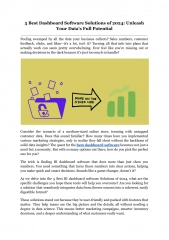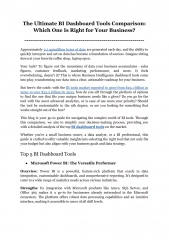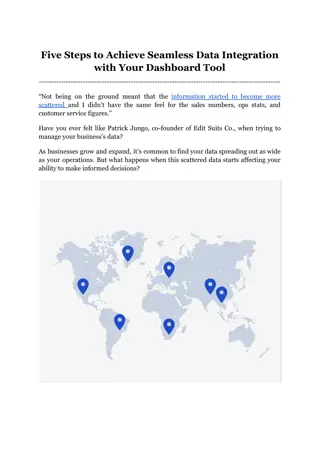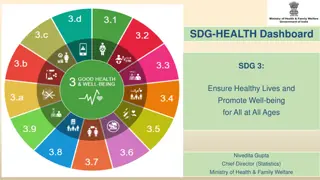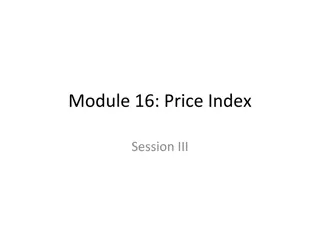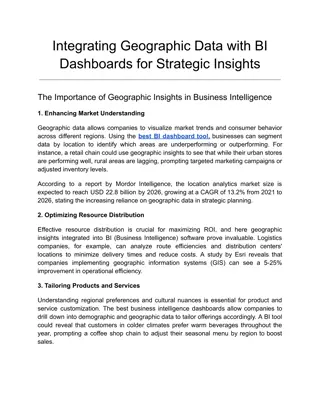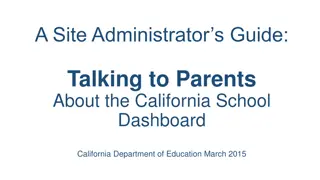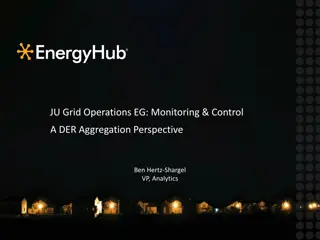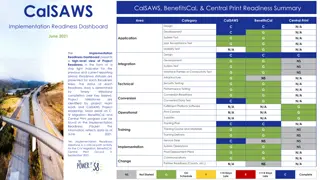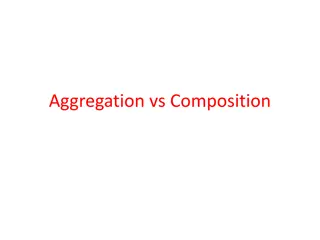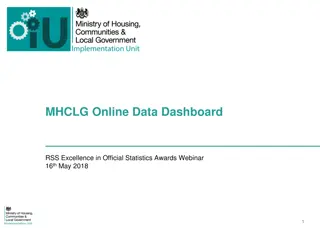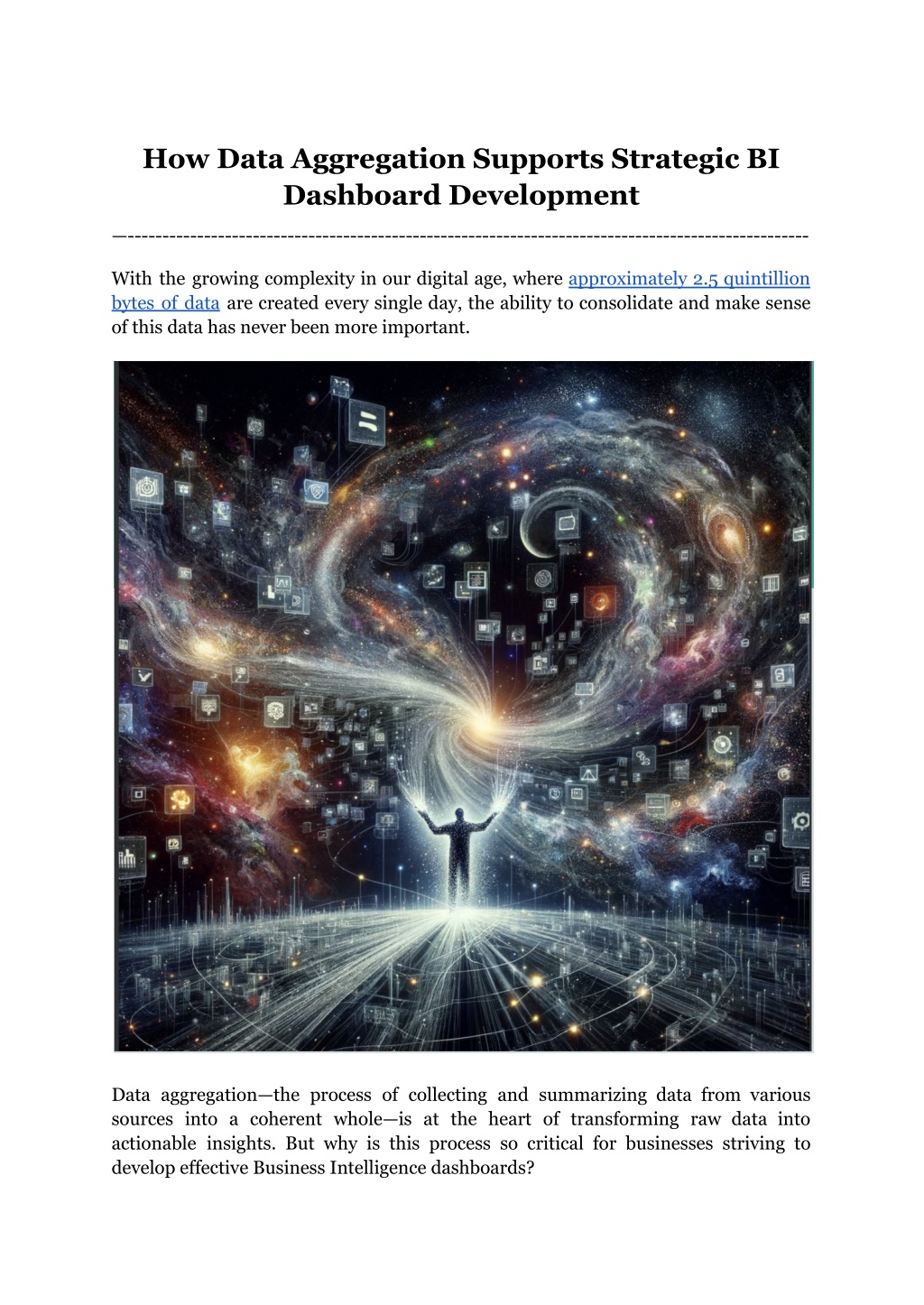
How Data Aggregation Supports Strategic BI Dashboard Development
This explores how combining data from different sources into a clear and organized format is key to making an effective Business Intelligence dashboard.
Download Presentation

Please find below an Image/Link to download the presentation.
The content on the website is provided AS IS for your information and personal use only. It may not be sold, licensed, or shared on other websites without obtaining consent from the author. Download presentation by click this link. If you encounter any issues during the download, it is possible that the publisher has removed the file from their server.
E N D
Presentation Transcript
How Data Aggregation Supports Strategic BI Dashboard Development -------------------------------------------------------------------------------------------------- With the growing complexity in our digital age, where approximately 2.5 quintillion bytes of data are created every single day, the ability to consolidate and make sense of this data has never been more important. Data aggregation the process of collecting and summarizing data from various sources into a coherent whole is at the heart of transforming raw data into actionable insights. But why is this process so critical for businesses striving to develop effective Business Intelligence dashboards?
The Critical Role of Data Aggregation in BI In the world of Business Intelligence tools, benefits from data aggregation are many. It refers to the process of collecting and summarizing data from various sources to provide a consolidated view. This process is pivotal in transforming raw data into actionable insights, a feature that stands at the heart of every effective Business Intelligence dashboard. For data aggregation to truly serve its purpose within a business dashboard software, it must start with high-quality, accurate data. The integrity of aggregated data is key; even the most advanced BI dashboard tool is rendered useless if it s based on flawed or inaccurate data. Thus, rigorous data cleaning and validation are non-negotiable steps in the data aggregation process. Types of data aggregation: temporal, spatial, and categorical Temporal Data Aggregation: Time as a Lens for Insight Definition and Importance: Temporal aggregation involves summarizing data over specific time intervals such as hours, days, weeks, or years to identify trends and patterns over time. This type of aggregation is crucial for any Business Intelligence dashboard focusing on historical analysis, forecasting, and trend identification. Application in BI: By leveraging temporal aggregation, BI tools can provide businesses with insights into sales performance over different periods, customer behavior changes throughout the year, or operational efficiency trends. For instance, a retail company could use a BI dashboard tool to aggregate sales data by week to plan for inventory stocking better. Benefits: The primary benefit of temporal data aggregation within business dashboard software lies in its ability to highlight trends and seasonality, which are critical for forecasting and strategic planning. This temporal insight enables businesses to allocate resources more efficiently, anticipate market changes, and strategize promotions or product launches with greater precision. Spatial Data Aggregation: Understanding Geographic Patterns Definition and Importance: Spatial data aggregation summarizes data based on geographic or spatial variables, such as regions, cities, or GPS coordinates. It s
indispensable for businesses that operate in multiple locations or need to understand geographic influences on their data. Application in BI: Spatial aggregation in a Business Intelligence dashboard can uncover regional performance trends, market penetration, and customer distribution patterns. For example, a logistics company could use spatial aggregation to analyze delivery times across different cities, optimizing routes and improving service levels. Benefits: The advantage of using spatial data aggregation in BI dashboard tools is the ability to visualize data geographically, offering a clear view of regional trends and disparities. This insight is crucial for location-based planning, market analysis, and resource allocation, allowing businesses to tailor strategies to specific geographic contexts. Categorical Data Aggregation: Segmenting for Strategic Insight Definition and Importance: Categorical aggregation groups data based on categories or segments, such as customer demographics, product types, or sales channels. This form of aggregation is essential for segment-specific analysis and targeted strategy development. Application in BI: Utilizing categorical aggregation, a BI tool can segment customer data by demographics to tailor marketing strategies or analyze sales by product category to identify high-performing products. This type of aggregation helps in customizing offerings and strategies to meet the specific needs and preferences of different segments. Benefits: The key benefit of categorical data aggregation in business dashboard software is its ability to provide a segmented view of the market, customers, or products. This detailed insight facilitates more personalized and effective strategies, enhances customer satisfaction, and optimizes product portfolios. Building Aggregation Blocks for Effective Data Data Integrity and Accuracy: The Foundation of Insightful Aggregation Ensuring Clean, Accurate Data: The accuracy of insights derived from a Business Intelligence dashboard hinges on the integrity and cleanliness of the underlying data. Effective data aggregation begins with rigorous data cleaning and
validation processes, removing inaccuracies, duplicates, and irrelevant entries to establish a reliable dataset for analysis. Tools and Techniques: Modern business dashboard software uses advanced data-cleaning tools and algorithms that automatically detect and correct errors. Techniques such as anomaly detection, pattern recognition, and consistency checks are instrumental in maintaining data quality. Additionally, validation procedures ensure that data adheres to predefined formats and standards, critical for accurate aggregation and analysis. Scalability and Performance: Catering to Evolving Data Demands Handling Large Datasets: As organizations grow, so too does the volume and complexity of their data. Scalability in data aggregation ensures that a BI dashboard tool can accommodate large datasets without compromising performance. This is paramount for businesses that rely decision-making processes. on real-time data to inform rapid Modern Data Processing Frameworks and Cloud Technologies: To achieve efficient data aggregation at scale, leveraging modern data processing frameworks and cloud technologies is essential. These platforms offer the computational power and flexibility needed to process and aggregate large volumes of data quickly, ensuring that business dashboard software remains responsive and efficient. Flexibility and Customization: Aligning Aggregation with Business Objectives Tailoring Aggregation to Dashboard Goals: The effectiveness of a Business Intelligence dashboard is significantly enhanced when data aggregation is tailored to meet specific organizational goals and requirements. This involves customizing aggregation parameters and methodologies to reflect the unique needs and objectives of the business. Dynamic Aggregation for User Queries: Advanced BI dashboard tools offer dynamic aggregation capabilities, allowing for real-time data aggregation based on user queries or specific dashboard focuses. This level of flexibility ensures that users can extract the precise insights they need, when they need them, enhancing the decision-making process. Security and Compliance: Safeguarding Data Throughout Aggregation Protecting Sensitive Information: In the process of data aggregation, the security of sensitive information must be a major concern. Encryption, access
controls, and secure data storage and transmission methods are essential components of a secure aggregation process, ensuring that data remains protected against unauthorized access or breaches. Adhering to Data Privacy Laws and Industry Regulations: Compliance with data privacy laws and industry regulations is non-negotiable in data aggregation. BI tools must be designed to comply with regulations such as GDPR, HIPAA, and others, depending on the geographical location and sector of operation. This not only protects the organization from legal repercussions but also builds trust with customers and stakeholders. Strategic Data Aggregation Dashboard Development with Aligning Aggregation Strategies with Business Goals Strategic Alignment: The first step in leveraging a BI dashboard tool effectively is ensuring that data aggregation strategies are in lockstep with the organization's business goals. This alignment means that every piece of aggregated data presented on the dashboard serves a purpose, whether it's driving sales, improving customer satisfaction, or optimizing operations. Business dashboard software excels when it translates vast data sets into focused insights that address specific strategic questions. Translating Data into Strategy: Aggregating data with an eye toward business objectives involves identifying key performance indicators (KPIs) that directly influence those objectives. By tailoring aggregation processes to these KPIs, businesses ensure that their Business Intelligence dashboard becomes a reflection of their strategic priorities, providing a clear path from data to decision-making. The Forecasting Role of Aggregated Data in Predictive Analytics and Predictive Power: Aggregated data is not just about understanding the past; it's a springboard into the future. Within a Business Intelligence dashboard, aggregated data serves as the foundation for predictive analytics and forecasting models. By identifying patterns and trends within the aggregated data, BI tools can forecast future outcomes, providing businesses with a predictive lens through which to view potential scenarios. Driving Proactive Decision Making: The ability to predict future trends allows businesses to shift from reactive to proactive strategies. Whether it's anticipating market shifts, consumer behavior changes, or supply chain disruptions, the insights
garnered from predictive analytics enable organizations to make informed decisions ahead of time, leveraging the Business Intelligence tools benefits to their fullest. Enhancing User Experience with Aggregated Data: Customization and Interactivity Customization Is Key: One size does not fit all when it comes to data analysis and presentation. A BI dashboard tool that excels in customization allows users to tailor the dashboard to their specific needs and preferences, ensuring that the aggregated data is relevant and actionable. This level of customization enhances the dashboard s utility across different departments and roles within the organization. Interactivity Engages: Beyond customization, interactivity plays a crucial role in enriching the user experience. Interactive BI dashboard tools empower users to explore data, drill down into specifics, and manipulate variables to see different scenarios. This hands-on approach not only makes the data more accessible but also encourages deeper engagement and understanding, further amplifying the Business Intelligence tools benefits. Conclusion As we conclude, it's clear that the Business Intelligence tools benefits, especially when powered by effective data aggregation, are vast and varied. Whether it's driving sales, improving customer satisfaction, or optimizing operations, a well-developed BI dashboard is an indispensable tool for any organization striving to harness the power of data for strategic advantage. For those looking to explore the transformative potential of BI dashboards further, Grow offers a robust BI dashboard tool designed to cater to your business's unique needs. With Grow's 14-day free trial, you have the opportunity to experience firsthand the power of strategic dashboard development with advanced data aggregation capabilities. Dive into Grow Features & Capabilities GetApp and discover how you can leverage Grow to turn data into your most valuable strategic asset. Take the first step towards unlocking the full potential of your data with Grow's BI dashboard tool and pave the way for informed, data-driven decision-making that propels your business forward.

